Unveiling the Allure of 3 Carat Diamonds: A Deep Dive
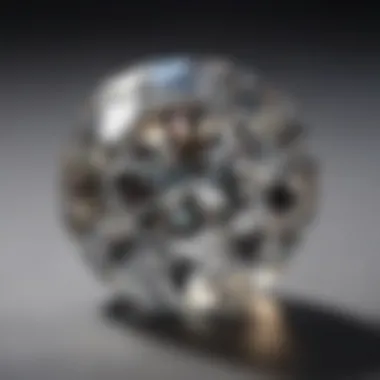
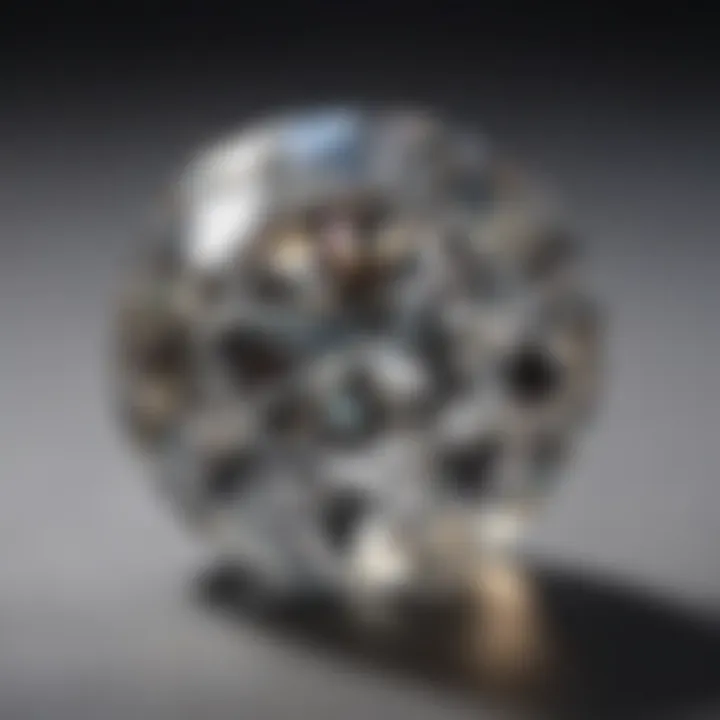
Intro
Three-carat diamonds possess a unique charm and significance in the realm of gemstones. This article aims to navigate the complexities of three-carat diamonds, focusing on their characteristics, grading criteria, market trends, and the factors that influence their value. Understanding these elements will equip potential buyers and gemstone enthusiasts with the necessary insights to make informed decisions.
Gemstone Overview
Definition and Characteristics
A three-carat diamond is defined primarily by its weight, equating to approximately 0.6 grams. However, this weight alone does not determine a diamond's overall value or appeal. Quality factors such as cut, color, clarity, and carat weight significantly influence its desirability.
- Cut: The cut defines how well the diamond reflects light. A well-cut diamond will exhibit brilliance and scintillation, making it visually captivating.
- Color: Diamonds range from colorless to various shades of yellow and brown. Generally, colorless diamonds are more sought-after, enhancing the value of three-carat stones.
- Clarity: This assesses the presence of inclusions or blemishes within the diamond. Higher clarity grades indicate fewer imperfections, leading to a more valuable gemstone.
Classification of Gemstones
Gemstones can be classified into two main categories: precious and semi-precious. Diamonds fall under the precious category due to their rarity and the superior qualities they exhibit. Within the diamond category, other classifications might include lab-grown and natural stones, with each having distinct attributes affecting their market value.
Historical Significance
Ancient Uses and Cultural Importance
Diamonds have been prized throughout history. In ancient times, they were believed to possess protective properties, serving as talismans. Cultures across the globe associated diamonds with powerful symbolism, where they represented strength, invincibility, and wealth.
Myths and Legends Surrounding Gemstones
Various myths surround diamonds and their allure. For instance, in some cultures, it is said that diamonds can bring good fortune or act as a bridge between the physical and spiritual realms. Such stories contribute to the overall mystique associated with three-carat diamonds and enhance their appeal in modern markets.
"The allure of a diamond extends beyond its physical presence; it encapsulates dreams, aspirations, and the history of human expression throughout ages."
This exploration dives deep into the essence of three-carat diamonds, aiming to assist enthusiasts in navigating an intricate and often intricate market.
Understanding Carat Weight
Understanding carat weight is the cornerstone of gauging a diamond's value and appeal. The carat is a measure of weight used to describe the size of a diamond, and it carries significant implications both for buyers and collectors. When particularly discussing a 3 carat diamond, understanding carat weight is crucial. It provides insight into not only the size and presence of the gemstone but also aspects like pricing and market demand.
What is a Carat?
A carat is defined as a unit of weight equivalent to 200 milligrams. This measurement is standardized globally, ensuring that buyers know the weight of the diamond they are purchasing. The term carat comes from carob seeds, which were historically used as a balance scale for trading gems.
A larger carat weight naturally contributes to the diamond's allure, as larger stones often catch the eye more easily. However, it is important to note that a diamond's physical size is not solely determined by weight. The cut and proportions also play a significant role in its apparent size.
Significance of Carat Weight
Carat weight has a direct impact on a diamond's value. Generally, as the weight increases, so does the price per carat. This is due to the rarity of larger diamonds: larger stones are much less common than smaller ones. Therefore, a 3 carat diamond can command a much higher price compared to smaller carat weight diamonds due to its rarity and visual impact.
Furthermore, carat weight is essential in determining how a diamond will be perceived. Consumers often associate larger carat weights with luxury and grandeur. When considering an investment, knowing the significance of carat weight can guide purchasing decisions and potential resale values in the future.
Measuring Carat Weight
Measuring carat weight is done using precision scales, specifically designed for gemstones. The measurement process is straightforward, but it must be done accurately to avoid discrepancies. Each diamond is weighed before it is mounted to ensure precision in reporting weight.
It's essential to understand that carat weight alone does not determine a diamond's overall quality. Factors like cut, clarity, and color contribute to the final valuation and should not be overlooked.
In summary, understanding carat weight extends beyond basic knowledge; it involves an appreciation for how this weight influences value, size perception, and market dynamics. A well-informed consumer is better positioned to make astute purchasing decisions.
The Carat Diamond Defined
Understanding a 3 carat diamond involves more than just its weight. This carat size represents a significant investment in quality and aesthetics. Knowing the characteristics and visual impact of a 3 carat diamond helps buyers make more informed choices, particularly given the nuances that influence both desirability and price.
Characteristics of a Carat Diamond
A 3 carat diamond is often seen as entrancing due to its size and presence. In technical terms, one carat equals 200 milligrams, thus a 3 carat diamond weighs 600 milligrams. Its size is not merely a factor of weight; it also affects the visual proportion of the diamond.
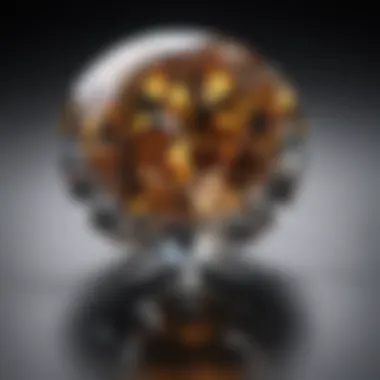
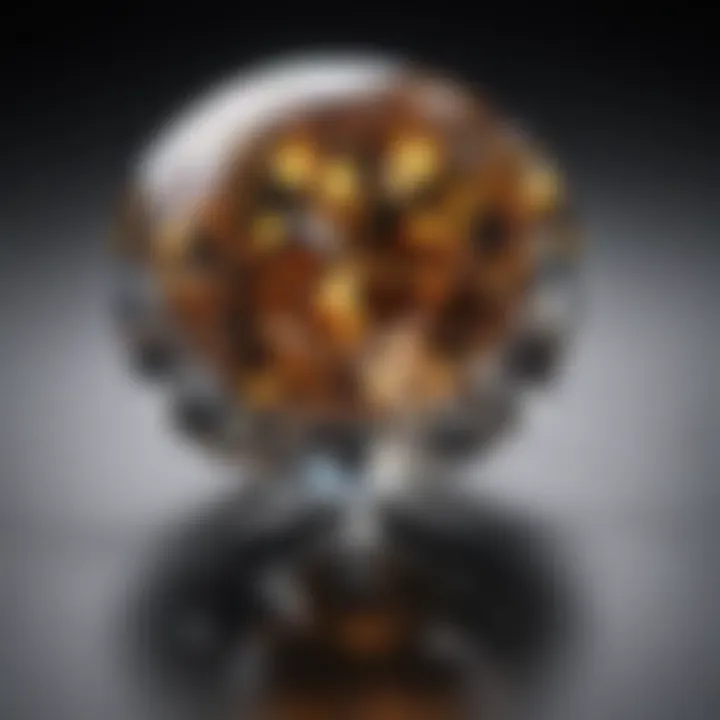
Generally, 3 carat diamonds are classified to be among the larger diamonds available in the market. Their characteristics include:
- Clarity: The level of internal flaws or inclusions visible to the eye. Larger diamonds can sometimes showcase these imperfections more evidently.
- Color: The less color a diamond has, the better its quality is considered. In larger stones, even minor color tints may be more noticeable.
- Cut: This greatly affects how the diamond reflects light. It refers to the quality of how a diamond has been shaped and polished.
While the allure of a 3 carat diamond is apparent, understanding its specific characteristics can significantly influence a buyer’s decision.
Visual Impact and Size
The visual impact of a 3 carat diamond is striking. Its substantial size elevates any design, making it not just a piece of jewelry but a prominent statement. People often respond to larger stones differently due to their noticeable presence.
In practical terms, here are some considerations regarding size and visual impact:
- A 3 carat diamond typically requires a suitable setting to highlight its beauty. Popular choices include solitaire, halo, and three-stone settings, each enhancing the gem's appearance.
- For individuals with smaller hands or smaller fingers, a 3 carat diamond can appear even larger than it is. This contrasts with the visual effect on larger hands, where the stone might seem more proportional.
- The perception of brilliance and scintillation largely depends on the cut, significantly impacting how the diamond interacts with light.
"When considering a diamond, its weight and dimensions are as crucial as its visual presentation. A larger diamond can capture light in unique ways, enhancing its allure."
Quality Factors: The Four Cs
The Four Cs of diamonds—cut, color, clarity, and carat weight—are crucial factors that determine a diamond's overall quality and value. For a 3 carat diamond, understanding these elements is vital. Each C contributes not only to the aesthetic appeal but also to the diamond's durability and market price. Buyers seeking to invest or acquire a 3 carat diamond must analyze these aspects thoroughly.
Cut
The cut of a diamond refers to how well the diamond has been shaped and faceted. This factor greatly influences how light interacts with the stone. A well-cut diamond reflects light brilliantly, showcasing its beauty. In the case of a 3 carat diamond, the balance between size and cut quality is essential. A superb cut can enhance the visual impact, making the diamond appear larger and more radiant.
Factors to consider in cut quality include:
- Proportions: The angles and dimensions of the facets.
- Symmetry: How well the facets align and correspond with one another.
- Polish: The smoothness of the surface.
To evaluate cut quality, look for a certification from a recognized institute like the Gemological Institute of America (GIA) or the American Gem Society (AGS).
Color
Color in diamonds describes the lack of color; the less color present in a diamond, the more valuable it is considered. Diamonds are graded on a scale from D (colorless) to Z (light yellow or brown). A 3 carat diamond that exhibits minimal color will have higher desirability. Color affects how the diamond interacts with light. For example, a D-color diamond will reflect light more vividly than one with noticeable color.
Choosing the right color grade is subjective; some people may prefer a diamond with a slight tint. Consider personal preference alongside potential resale value when deciding.
Clarity
Clarity assesses the presence of internal or external flaws known as inclusions and blemishes, respectively. A clarity grade is provided based on how many imperfections exist and how visible they are. High clarity grades, like IF (Internally Flawless) or VVS (Very Very Slightly Included), significantly increase a diamond's value. A 3 carat diamond with a higher clarity rating not only looks better but also signifies better craftsmanship.
It's crucial to inspect diamonds closely. Using a jeweler's loupe or microscope can help identify clarity characteristics.
Carat
While carat weight is already established as being three carats in this context, understanding its implications is vital. Carat refers to the weight of the diamond, with one carat equaling 200 milligrams. The price of diamonds does not increase linearly with carat weight. A 3 carat diamond can be significantly more expensive per carat than a smaller diamond.
Additionally, often, the visual size may vary depending on cut and shape, so a well-cut 3 carat diamond may appear larger than a poorly cut diamond of the same carat weight. Thus, it’s important to balance cut, color, and clarity against carat weight when evaluating a diamond's overall value.
"The Four Cs are the language of diamond quality and define both its price and prestige in the gemstone world."
This nuanced understanding of the Four Cs empowers buyers to make informed decisions when choosing a 3 carat diamond, one that aligns with both their aesthetic preferences and investment goals.
Market Trends for Carat Diamonds
Understanding the market trends for 3 carat diamonds is essential for both buyers and sellers. The diamond market changes based on various factors such as demand, pricing, and consumer preferences. By analyzing current trends, one can make informed decisions when buying or investing in diamonds. Knowing the trends not only helps to establish the value of a diamond but also allows potential investors to gauge if it is a good time to buy.
Current Market Demand
The demand for 3 carat diamonds reflects broader market trends in jewelry purchasing. As consumer preferences lean toward larger and more visually impressive stones, the interest in 3 carat diamonds has notably increased. According to various market studies, millennials and younger generations see diamond purchases not just as an investment but also as a personal statement.
Several factors play into this current demand:
- Emotional Significance: Diamonds are often purchased for celebrations and milestones, leading to increased demand around anniversaries and engagements.
- Cultural Influence: Social media has a role in shaping preferences. More couples wish to showcase larger stones, leading to a bump in inquiries for three-carat options.
- Global Economy: Economic stability generally enhances spending power, contributing to a robust market for luxury items, including diamonds.
Pricing Dynamics
Pricing for 3 carat diamonds can be complex, influenced by various elements such as quality, market demand, and seller location. The price of diamonds is not static and can change based on several dynamics:
- Quality Factors: The Four Cs—Cut, Color, Clarity, and Carat—determine a diamond's overall value. For instance, if two 3 carat diamonds have similar quality, the one with a better cut typically commands a higher price.
- Supply and Demand: A surge in demand affects pricing, particularly when specific styles or shapes become trendy. Sellers might adjust prices based on consumer interest.
- Market Sentiment: Events such as economic downturns or financial crises can alter consumer desire for luxury purchases, often leading to drops in pricing.
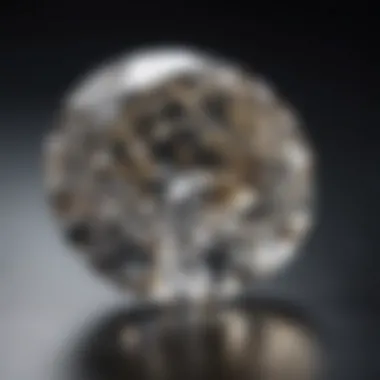
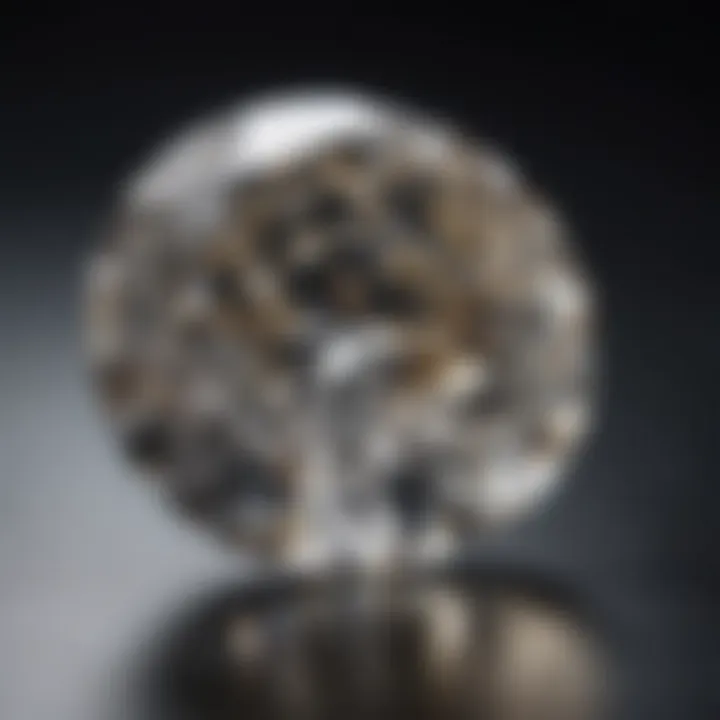
"Understanding the nuances of diamond pricing can lead to smarter investments and purchases."
In summary, being aware of the current market demand and pricing strategies helps buyers navigate through their options more effectively. The insights into trends discussed here can empower consumers and collectors to make decisions aligned with market realities.
Investing in Carat Diamonds
When considering a purchase of a 3 carat diamond, it is essential to regard it not merely as an aesthetic addition to one’s collection, but also as a tangible investment. The nature of diamonds, especially those at the 3 carat mark, inherently appeals to both collectors and investors. This section delves into two critical dimensions: value retention and long-term worth. These elements are vital for making an informed decision, especially in the volatile realm of gemstone markets.
Value Retention
Value retention is a crucial factor in determining the desirability of a 3 carat diamond. Diamonds are not just luxury items; they are commodities that can retain or appreciate in value over time. Generally, gemstones are subject to market demand, rarity, and overall quality. A well-chosen 3 carat diamond, particularly one with high clarity, color, and cut, tends to maintain its value effectively compared to lower carat weights.
To understand why value retention matters, consider the following factors:
- Market Demand: As noted, larger stones like 3 carat diamonds often attract greater interest. In a market where buyers seek quality pieces, these diamonds tend to hold their worth better than smaller or less impressive stones.
- Rarity: The rarity of high-quality 3 carat diamonds can contribute significantly to their value retention. Stones that are certified and graded have better prospects for maintaining value over time.
- Condition: Proper maintenance and care enhance the longevity and aesthetic appeal of a diamond, directly influencing its resale value.
"Investing in high-quality diamonds is akin to investing in art; it requires knowledge, insight, and attention to detail."
Long-Term Worth
The potential for long-term worth in investing in a 3 carat diamond cannot be overstated. As with many investments, the perception of value expands with time. A diamond does not simply reflect current trends but can be seen as a legacy piece that can be passed on through generations. A few key points highlight this:
- Historical Appreciation: Historically, diamonds have shown a tendency to appreciate, particularly during periods of economic stability. As diamond prices fluctuate, those who invest wisely often see returns that exceed standard financial investments.
- Changing Trends: Shifts in consumer preferences can create or diminish desirability. Adapting to these trends can help collectors position themselves advantageously, ensuring their 3 carat diamonds remain appealing.
- Market Resilience: Diamonds, especially from reputable sources, can exhibit resilience against economic downturns, providing security to those investing.
In summary, investing in a 3 carat diamond represents a multifaceted opportunity that merges aesthetic appeal and economic potential. Understanding value retention and long-term worth equips buyers and collectors with the necessary insights to navigate the intricate world of diamond investments effectively.
Choosing the Right Carat Diamond
Selecting a 3 carat diamond is a significant decision. The value, appearance, and overall quality can vary widely among diamonds of the same size. Therefore, understanding what constitutes the ideal choice for you is essential. The right diamond should not just meet an aesthetic preference but also fit within your budget and investment strategy. Factors such as personal taste, style, and the intended purpose of the diamond—be it an engagement ring or a statement piece—will have a notable impact on your final decision.
Personal Preferences
When choosing a 3 carat diamond, personal preferences play a crucial role. A diamond's visual appeal is subjective. Factors such as shape, cut, and setting should be carefully considered. Some individuals prefer the traditional round cut, recognized for its brilliance. Others may gravitate toward fancy shapes like princess, oval, or pear, which lend a unique touch to the stone.
Additionally, color and clarity preferences can affect your choices. A stone with higher clarity may appeal more to some, while others prioritize color saturation or even the presence of inclusions, which can add character. When selecting a diamond, think about where and how you plan to wear it most often. It is wise to imagine the piece in everyday settings or special occasions. Consider visiting various jewelers to explore different styles firsthand. They may offer insights that refine your preferences.
Consulting Professionals
Engaging with professionals can enhance your understanding when choosing a 3 carat diamond. Graduate gemologists, such as those associated with organizations like the Gemological Institute of America (GIA), can provide valuable insights. Their knowledge ensures that buyers can make informed decisions based on diamond grading, which is influenced by the Four Cs: cut, color, clarity, and carat weight.
Consultations with experienced jewelers also offer perspectives on current market trends and pricing dynamics. These experts may suggest particular styles or settings that align well with your preferences while ensuring that you understand the value of the piece you are purchasing. Both online and offline sources have information that can guide you to knowledgeable professionals.
Choosing the right diamond is not solely about the stone, but also about the story it will tell.
In summary, taking the time to evaluate your personal preferences and consulting professionals builds a solid foundation for your choice of a 3 carat diamond. Awareness and expertise can lead to a purchase that resonates well in both emotional and financial aspects.
Caring for Your Carat Diamond
Maintaining the allure of a 3 carat diamond is crucial for its longevity and brilliance. Diamonds, while known for their hardness, can still succumb to dirt, oils, and scratches. Proper care ensures your diamond retains its sparkle and value over time. Let's delve into the specific elements of cleaning and maintenance, as well as storage considerations for your precious gem.
Cleaning and Maintenance
Regular cleaning is essential to keep your 3 carat diamond looking its best. Accumulated dirt and oils from daily wear can cloud the stone’s surface, diminishing its brilliance. You can clean your diamond at home using mild soap and warm water. Soak the diamond for a few minutes, then gently scrub it with a soft brush, paying attention to any settings or crevices where dirt may hide. Rinse well and dry with a soft cloth. Alternatively, consider professional cleaning services that can offer deeper cleaning and inspection.
Some important tips for maintaining your diamond include:
- Avoid harsh chemicals: Cleaning products with bleach or ammonia can damage certain settings and treatments.
- Remove before activities: Take off your diamond when engaging in activities that could cause damage, like exercising or gardening.
- Regular checkups: Have a jeweler inspect the setting and overall condition regularly, ideally once a year. This helps catch any potential issues before they become significant problems.
"Regular maintenance not only prolongs the life of your diamond but also preserves its value, making it a wise investment."
Storage Considerations
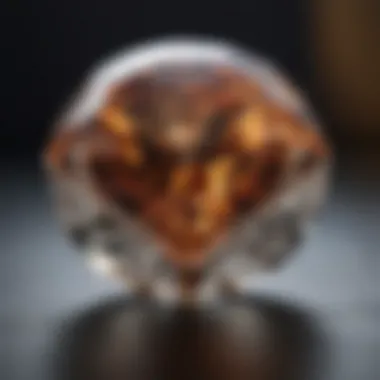

Proper storage is vital in preserving the integrity of your 3 carat diamond. Store your diamond in a soft cloth pouch or a dedicated jewelry box to prevent scratches from other pieces. Diamonds, while durable, can scratch softer gemstones and other metals. Organizing your jewelry collection can also prevent tangling and damage.
Consider the following storage tips:
- Individual compartments: Use a jewelry box with separate compartments to house the diamond. This keeps it safe from friction damage.
- Away from sunlight: Store your diamond away from direct sunlight to avoid fading or altering any accompanying materials.
- Humidity control: Keep your storage area dry and at a stable temperature, as extreme conditions can affect the diamond's settings over time.
Following these care tips ensures that your 3 carat diamond remains stunning and valuable for generations. The attention to detail in care can profoundly affect both the aesthetic and financial value of your precious gem.
The Historical Context of Diamonds
The historical background of diamonds provides a vital understanding of their value and significance in various cultures. From ancient times to the present day, diamonds have captured the human imagination and symbolized wealth, power, and love. This section explores the cultural significance of diamonds and discusses how their market value has evolved over time.
Cultural Significance
Diamonds have been revered for centuries. In ancient India, they were seen as the ultimate symbol of status and were believed to have protective qualities. They adorned the crowns of kings and were often used as talismans. Their appearance in royal treasuries emphasized their worth not just as adornments but also as symbols of authority. In the Western world, the perception of diamonds shifted dramatically during the 20th century, especially after the famous De Beers advertising campaign stating that a "diamond is forever." This phrase solidified the diamond's status as the premier choice for engagement rings, linking it firmly to love and commitment.
Culturally, diamonds served purposes beyond mere ornamentation. Many cultures incorporated diamonds into religious artifacts, believing they could enhance spiritual protection or connection. Today, the diamond continues to serve as a popular choice for significant life events, often representing milestones such as engagements, anniversaries, and other special occasions. Its cultural resonance ensures that diamonds maintain a potent symbolic role in human relationships, making their historical context crucial for understanding their current appeal.
Evolution in Market Value
The market value of diamonds has undergone notable transformations over centuries. In the early days, diamonds were rare and mainly sourced from India, leading to exorbitant prices due to their scarcity. However, the discovery of the Kimberley mine in South Africa in the late 19th century significantly increased supply. This event led to notable shifts in pricing dynamics, making diamonds more accessible yet also altering their perceived value.
In contemporary times, market trends reveal fluctuations due to various factors, including economic changes and shifts in consumer preferences. The rise of synthetic diamonds has created new considerations regarding the value of natural diamonds. As consumers become more eco-conscious, the appeal of lab-grown diamonds is gaining traction. This has prompted traditional diamond sellers to adapt their marketing strategies to maintain an edge in the market.
Moreover, the rise of online marketplaces has transformed how diamonds are sold and valued. Instant access to information allows consumers to compare prices, greatly impacting market demand.
The historical context surrounding diamonds shows how deeply intertwined their value is with cultural beliefs and shifts in market dynamics, making it essential for potential buyers and collectors to grasp these intricate connections.
In summary, the historical context of diamonds is multifaceted. It reveals the gemstones' lengthy association with power and beauty, alongside evolving market values affected by consumer habits and technological advances. Understanding this backdrop not only enriches the appreciation for such gems but also informs smart purchasing decisions in today's market.
Alternative Options to Carat Diamonds
When considering a three-carat diamond, it’s essential to recognize that there are various alternatives available on the market. These options offer distinct advantages and suit different preferences and budgets. Understanding these alternatives allows buyers to make informed decisions while exploring their choices in the gemstone space.
Other Carat Weights
The market provides a range of carat weights beyond three carats. Each weight has unique characteristics and pricing that can appeal to various buyers. For instance, two-carat and four-carat diamonds become comparably significant in terms of both appearance and price.
- Two-Carat Diamonds: Generally more affordable than their three-carat counterparts, two-carat diamonds offer a substantial presence without reaching higher price points. Their size can still deliver a remarkable visual impact.
- Four-Carat Diamonds: This size showcases even larger dimensions, which can create a more luxurious appearance. However, the premium price can be a decisive factor for many buyers.
- Half and Quarter Carat Options: Smaller diamonds, such as one and one-and-a-half carats, often appeal to those who prefer subtlety or are purchasing an engagement ring on a lower budget.
With the variety of carat weights available, buyers can explore what best fits their expectations and aesthetic desires.
Synthetic Diamonds
Synthetic diamonds present an innovative alternative to natural diamonds. Also known as lab-created diamonds, these gemstones have gained popularity as they provide several practical advantages. Understanding their traits can assist buyers in determining suitability for their needs.
- Cost Efficiency: Synthetic diamonds usually sell for 20-40 percent less than their natural mined counterparts. This cost benefit allows for a higher quality gemstone within the buyer's budget.
- Ethical Considerations: Lab-created diamonds address concerns over the ethical implications of mining. They offer an environmentally friendly alternative, promoting responsible sourcing in the diamond industry.
- Identical Composition: Chemically, synthetic diamonds are indistinguishable from natural diamonds. They share the same physical and optical properties, making them a practical choice for those seeking beauty and brilliance without the high price tag.
In summary, alternatives to three-carat diamonds, including various carat weights and synthetic options, provide accessible paths to beautiful gemstones. Each choice carries its own benefits and considerations, allowing buyers to select the perfect piece that aligns with their personal style and values.
Emerging Trends in Diamond Styles
The diamond industry constantly evolves, responding to both consumer preferences and technological advancements. Emerging trends in diamond styles complement the traditional aspects of diamond jewelry while introducing fresh perspectives that appeal to a modern audience. Understanding these trends is essential for buyers, collectors, and designers alike as they can significantly influence purchasing decisions and market dynamics.
Fancy Shapes and Cuts
Fancy shapes and cuts refer to diamonds that deviate from the classic round brilliant shape. Shapes such as oval, pear, marquise, and cushion are gaining popularity. Each shape has unique characteristics that contribute to its appeal. For instance, the oval cut can create the illusion of a larger size and enhances the overall elegance of the piece. Similarly, the pear shape offers a distinct silhouette that many find attractive.
Recent trends have seen increased interest in more unconventional cuts such as the hexagonal and radiant shapes. These shapes appeal to individuals seeking uniqueness and personalization in their jewelry. They stand out in a market saturated with traditional designs, allowing wearers to make a statement.
Buyers should consider factors such as symmetry, proportion, and light performance when selecting fancy shapes. Understanding how a shape interacts with light can enhance its beauty. Moreover, the shape of the diamond can influence how settings and styles are chosen to complement the gem, making it critical in the overall design.
Setting Variations
The setting of a diamond plays a crucial role in its presentation and overall aesthetic. Emerging trends emphasize innovative and diverse settings that cater to a variety of tastes. Traditional prong settings remain popular, yet many consumers opt for bezel settings or more intricate mountings that enhance the diamond's visual impact.
One notable trend is the rise of vintage-inspired settings. These include detailed metalwork and the use of smaller accent stones to create intricate designs. Such styles evoke a sense of nostalgia and timelessness, appealing to buyers who appreciate historical elements in their jewelry.
Alongside vintage designs, mixed-metal settings are gaining traction. By combining white gold, rose gold, and yellow gold, these settings provide depth and dimension that enhances the diamond's sparkle. This flexibility allows jewelers to customize pieces that reflect the individual preferences of the wearer.







